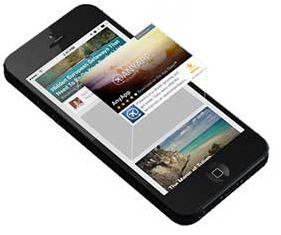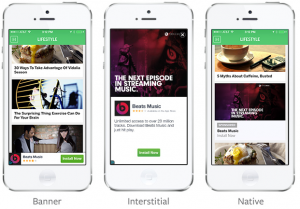The Facebook Audience Network: An Overview for Retailers

The power of Facebook ads, off Facebook. This is the theme the social media giant has pushed in regards to its Facebook Audience Network.
The program, which launched in October of 2014, is an advertising extension that offers additional ad placement on mobile websites and applications that have opted into the network.
Taking into consideration the ever-growing popularity of mobile usage and optimization, the program has seen a fair amount of success. After only two years, the company has reported reaching a $1 billion annual run rate on advertising spend through the Facebook Audience Network.
While the program’s success has been notable, a lot of retailers may be wary or unsure of how effective these ad types can be for their businesses.
Facebook advertising can be of so much value to businesses as it offers some of the most refined and in-depth interest-based data available. It’s ability to be so granular in its targeting options is immensely beneficial to retailers.
The company claims that all of the data that makes the rest of their advertising  platform so effective still remains constant throughout the Facebook Audience Network.
platform so effective still remains constant throughout the Facebook Audience Network.
The network is comprised of third-party apps and mobile websites approved by Facebook to host these ads – automatically making it easier to extend ad campaigns onto alternative mediums that customers use on a day-to-day basis.
Using the same targeting options as more “traditional” Facebook campaigns, your ad should have a higher likelihood of reaching your intended audiences off Facebook.
The premise is simple: create an ad on Facebook and you can choose to have placement extended to Facebook-approved third party mediums – such as mobile apps, mobile websites, Instant Articles, and videos – associated with the Audience Network.
The Audience Network extension can be selected during campaign creation and is applicable to the following objectives:
Additionally, ads shown within the Facebook Audience Network are delivered in three formats: Banner, Interstitial, or Native ads.

Because everything is based off of your regular campaign, this is all done with a single click and Facebook takes care of the rest.
At its core, the Audience Network is suitable for just about any advertiser looking to expand the reach of their Facebook campaigns. As long as your campaign is geared toward one of the aforementioned objectives, you’ll have the choice of implementing the advertising extension.
A variety of factors will play a role in how well ads within the network perform. Based on internal Facebook data, the company claims that:
That being said, the Audience Network is not a one-size-fits all situation. One of the major downsides to the Facebook Audience Network is advertisers don’t have much control over where or how the ad is displayed.
“You don’t know where your ads are going to be placed. You can include block lists and exclude placement on certain apps or websites you don’t want to be associated with, but you still don’t have control over where it will ultimately be displayed,” said Sarah Rogers, Senior Social Strategist at CPC Strategy.
apps or websites you don’t want to be associated with, but you still don’t have control over where it will ultimately be displayed,” said Sarah Rogers, Senior Social Strategist at CPC Strategy.
“With the Facebook Audience Network, you still have all the same levers and layers available for on-platform advertising. You get the same reporting, setup, and targeting options. It all carries over to the Audience Network. The only difference is you don’t know where it is.”
“With everything else, you know it’s in the Newsfeed or in the right hand rail. But with the Audience Network, you don’t really know.”
“It’s worth testing. We’ve seen that it actually has very low CPMs and CPCs, so you can serve a lot of people. For some retailers, it works and drives positive revenue. If you’re seeing people convert, it’s worth scaling up. It’s very much a test and learn type of thing.”
The Facebook Audience Network has also seen some changes recently. In May of this year, the company announced that it would be opening the capabilities of its Audience Network up to more than just Facebook users.
Previously, the network was limited to only being able to serve ads to signed-in Facebook users that engaged with third-party outlets, such as mobile apps and websites.
However, its scope has now broadened, expanding the reach of the Audience Network to display ads on third-party apps and sites to anyone who has ever visited Facebook; registered and non-registered users, alike.
The change is particularly interesting, as it speaks volumes to the direction Facebook is looking to head in with their advertising endeavors.
Andrew Bosworth, Facebook’s VP of ads and business, said in a press announcement:
“Today, we’re expanding Audience Network so publishers and developers can show better ads to everyone – including those who don’t use or aren’t connected to Facebook.
One of the things we’ve heard from people is that many of the ads they see are annoying, distracting, or misleading. We think companies can do better, and that’s why we’ve been focused on improving ads both on and off Facebook.
Advertising may be here to stay, but bad advertising like this doesn’t have to. That’s why we’re working to provide a better online advertising experience for everyone: people, publishers, and advertisers.”
The updates have not been completely rolled out as of yet, but the new changes are something to keep an eye on as time goes on.
There are two different tools advertisers can take advantage of to block ads from running alongside certain types of content across Facebook Audience Network placements.
Block lists give advertisers the ability to prevent ads from being displayed on specific sites or apps when campaigns are being run through the audience network. These can also be run against Instant Articles of specific publishers. Block lists can be uploaded at the ad set level and can be re-used across multiple campaigns. While the feature is already active, it is currently going through a gradual roll out and may not be available to all accounts quite yet.
In addition to uploading custom block lists, advertisers can utilize the category blocking feature. With category blocking, advertisers can prevent their ads from being displayed next to specific content categories by choosing the “Exclude Categories” option under the “Edit Placements” section of the ad set.
Audience Network and Instant Article ads can be excluded from the following content categories:
Facebook does note that a 100% percent block rate cannot be guaranteed, but will likely prevent it in most cases. It’s also important to keep in mind that incorporating category blocking or block lists will limit a campaign’s delivery and will result in fewer people seeing an ad.
Not a new feature, but still incredibly important is the advertiser outcome score. The advertiser outcome score (AOS) is the measurement system used to evaluate post-click ad performance in the Facebook audience network. A placement’s AOS reports how often the people who click an ad then go on to complete a conversion (app install, making a purchase, etc).
The AOS is significant for a couple of reasons. It is, of course, a performance metric and provides advertisers with another data point to gauge a campaign’s effectiveness with. Perhaps more importantly, though, the AOS is important because it affects the effective cost per thousand impressions (eCPM).

A higher score (which is graded on a scale of 1-14) means stronger placement level performance, and ultimately, higher CPMs. Conversely, a lower AOS score (meaning the system has determined a conversion is less likely after the initial impression) may result in reduced bid amounts.
At the end of the day, campaign and ad optimization should be geared toward final results, not just clicks. The AOS is Facebook’s way of measuring those efforts. It’s important to check out best practices on improving a campaign’s score.
For more information on the Facebook Audience Network, feel free to contact [email protected]
Facebook for Retail – How to Create the Best Facebook Ads
Facebook Product Ads: A Retailer’s Guide To Facebook Advertising
Why CPC Strategy is Launching a Facebook Service Line
